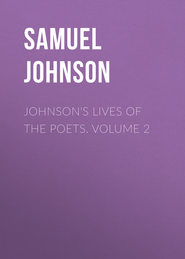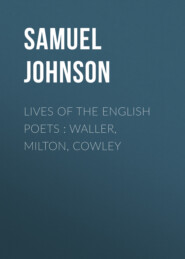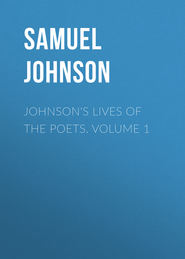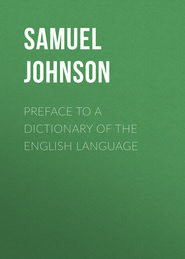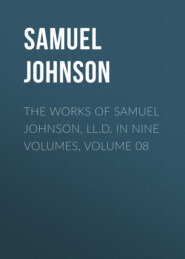По всем вопросам обращайтесь на: info@litportal.ru
(©) 2003-2025.
✖
Johnson on Savage: The Life of Mr Richard Savage by Samuel Johnson
Настройки чтения
Размер шрифта
Высота строк
Поля
2
Johnson heard of Savage’s death in Bristol in August 1743, through their mutual friend Edward Cave, the editor of the Gentleman’s Magazine. It was evidently a great personal blow to him, as he immediately determined to write Savage’s Life. Johnson had in fact already published several short biographical essays with Cave, notably on the piratical sailor Sir Francis Drake (1740), and the Dutch scientist Herman Boerhaave (1739). But this was to be his first attempt at a full length biography on a contemporary subject from original materials. It was also the first to be written con amore. It would eventually run to a book of 180 pages (45,000 words), much longer than any of his subsequent Lives of the Poets.
Within three weeks he announced his intention to defend ‘the unfortunate and ingenious Mr Savage’, in a long letter to the magazine that Cave published in September. The Life would ‘speedily be published by a person who was favoured with his Confidences, and received from himself an Account of most of his Transactions’. This Life would be authentic, and would preserve Savage’s memory from ‘insults and calumnies’. Johnson then made an historic and combative claim about the nature of biography, distinguishing it from romance or fiction.
It may be reasonably imagined that others may have the same Design, but as it is not credible that they can obtain the same Materials, it must be expected they will supply from Invention the want of Intelligence, and that under the Tide of the Life of Savage they will publish only a Novel filled with romantick Adventures, and imaginary Amours. You may therefore perhaps gratify the Lovers of Truth and Wit by giving me leave to inform them in your Magazine, that my Account will be published in 8vo by Mr Roberts of Warwick-Lane.
Johnson had several different kinds of material to draw on. For a start, he had talked a great deal with Savage, and heard his story at length from his own mouth. The accounts of Johnson and Savage walking and talking together all night through the London streets in 1737–8, especially around Westminster and St James’s Square, were eventually to became legendary. This is how Sir John Hawkins remembered them:
Johnson has told me, that whole nights have been spent by him and Savage in conversation of this kind, not under the hospitable roof of a tavern, where warmth might have invigorated their spirits, and wine dispelled their care; but in a perambulation round the squares of Westminster, St James’s in particular, when all the money the could raise was less than sufficient to purchase them the shelter and sordid comforts of a night cellar…
A later friend and biographer, the Irish poet Arthur Murphy, gently embroidered on Johnson’s memories, and moving their location slightly westwards into fashionable Mayfair, gave them an exquisite touch of Dublin absurdity. ‘Johnson has been often heard to relate, that he and Savage walked round Grosvenor Square till four in the morning; in the course of their conversation reforming the world, dethroning princes, establishing new forms of government, and giving laws to the several states of Europe, till fatigued at length with their legislative office, they began to feel the want of refreshment; but could not muster up more than fourpence halfpenny.’
It is therefore particularly interesting that Johnson chooses never to introduce himself explicitly into the Life of Savage. This reticence is unlike, for example, Boswell who appears in propria persona throughout his Life of Johnson (1791); or William Godwin who plays a decisive role in the second half of his Memoirs (1798) of Mary Wollstonecraft. Johnson makes only one passing reference to himself in the third person, at the fateful moment in 1739, when Savage finally leaves London for Wales, never to return. Yet this moment is intensely emotional.
‘Full of these salutary resolutions, [Savage] left London in July 1739, having taken leave, with great tenderness, of his friends, and parted with the author of this narrative with tears in his eyes’, (p.85). Johnson’s sentence seems to leave deliberately ambiguous whether the tears belonged to himself or Savage. Perhaps this was deliberate. But in a marginal note later added to a copy he was correcting in 1748, Johnson wrote: ‘I had then a slight fever’. This surely claims the tears - and the intense emotion - as his own.
Johnson’s personal identification with Savage’s fate is one of the most subtle issues underlying the entire biography. It deeply affects his partial handling of evidence, and wonderfully colours the continuous, shifting ambiguity of its narrative tone. Young Johnson makes common cause with Savage, in his bohemian style of life, his love of late-night talk, his proud sense of being a social outcast, and in his intense political anger at oppression by the rich and powerful. Yet this same self-identification produces strange biographical distortions. How deeply Johnson’s feelings were engaged, and how far objective biography becomes distilled into subjective autobiography, is one of the enduring mysteries of its power, and raises larger questions about the whole genre.
3
Johnson took about 3 months compiling and expanding the biography, between mid-September and 14 December 1743, when he signed a receipt for 15 guineas on delivery of the manuscript to Cave. In January 1744, in a deadline crisis familiar to many biographers, he ‘sat up all night’ correcting and revising the last ‘forty-eight pages of the printed octavo’, probably because he had just received copies of Savage’s last three letters from Bristol. The Life was finally published in February 1744.
During this time he sent several notes to his editor, many of them giving painful glimpses of the Grub Street writer’s life which he had shared with Savage. Once, the printer’s boy finds Johnson ‘writing this, almost in the dark’ because he lacks candles. Later he is writing hard but lacks ‘good Pens’. Then he has been ill, the writing has been interrupted, but he is ‘almost well again’ and so humbly begs ‘another Guinea’ in advance. Finally, most bleakly of all, he is ‘impransus’- supperless. Meanwhile he bombards Cave with requests for further information. ‘Towards Mr Savage’s Life what more have you got?’ He asks for a transcript of Savage’s trial for murder; for a copy of his Defence speech at the Old Bailey, and a copy of his 1726 Miscellaneous Poems, ‘on account of the Preface’ which attacks Lady Macclesfield. He also wants some articles in the Plain Dealer describing Savage’s case, and ‘all the Magazines that have anything of his or relating to him’.
Johnson had all Savage’s major publications to draw on, and several of his rare letters (less than 30 are known) preserved by Cave at the Gentleman’s Magazine, especially those Savage had written from Newgate Gaol in Bristol in 1743. Johnson would use extracts from these to powerful effect in the final section of the Life, showing the extraordinary shifts in pose and self-presentation which Savage was capable of adopting. Even when cornered and reduced to the most desperate circumstances, Savage was incorrigeable and changeling-like.
He also had copies of the poems and essays that Aaron Hill had published during the Plain Dealer’s campaign of 1724 to establish Savage’s claim against Lady Macclesfield. Most remarkable among these was Savage’s ‘Lament’, published in June 1724. In it Savage transforms his ‘cruel Mother’ into a cruel Lover.
Hopeless, abandoned, aimless, and oppress’d,
Lost to Delight, and every Way distress’d;
Cross his cold Bed, in wild Disorder thrown,
Thus sigh’d Alexis, friendless and alone –
’Why do I breathe? - What joy can Being give?
When she, who gave me Life, forgets I live!
Feels not these wintry blasts; - nor heeds my Smart;
But shuts me from the Shelter of her Heart!…
In the first edition of the Life, Johnson printed extensive extracts from these works in a score of footnotes, many of them several pages long, which almost amounted to a separate anthology. Besides the ‘Lament’, he drew notably on the libelous (and hastily suppressed) ‘Preface to the Miscellaneous Poems’ of 1726, ‘The Bastard’, The Wanderer, The Volunteer Laureates’, and ‘London and Bristol Delineated’. Though fascinating, they obstruct the natural flow of the biographical narrative, and he eventually omitted them in definitive edition incorporated into the Lives of the Eminent English Poets in 1781.
4
Johnson had one other major biographical source of information. He obtained from Cave a 29 page pamphlet written anonymously at the time of Savage’s conviction for murder in 1727. It was entitled The Life of Mr Richard Savage…Who was Condemned at the last Sessions of the Old Bailey, for Murder…With some very remarkable Circumstances relating to the Birth and Education of that Gentleman, which were Never before made Publick. This was the pamphlet, hurriedly organized by Aaron Hill, intended to save Savage from the hangman’s noose. It was dashed off in 2 days by a fellow Grub Street journalist, one Thomas Cooke, who worked in the upstairs room of a Fleet Street tavern, hoping to save ‘a brother poet - how unworthy soever of the appellation’ from the gallows. It was from this work that Johnson drew his extraordinary portrait of Lady Macclesfield, which dramatically sets the combative tone of the opening.
Johnson’s righteous anger is felt throughout this early section, with an unrelenting series of attacks on Lady Macclesfield’s ‘barbarous’, ‘cruel’ and ‘unnatural’ behaviour. He recounts a breathless (and gripping) series of incidents in which she denies Savage’s birthright, suppresses his name, farms him out to a nurse, frustrates a £300 inheritance, attempts to apprentice him to a shoemaker, and dispatch him to the American colonies. Finally she promotes his execution by seeking to prevent the royal pardon, (p.26–7)
The mounting bitterness of these accusations, their rhetorical force, and their melodramatic repetitions, cannot quite hide from an alert reader their curious and unsubstantiated nature. Most problematic of all, Johnson can find no real motive - moral, prudential or pecuniary - for these maternal crimes, (p.5). Yet it is difficult to doubt Johnson’s good faith, and since Lady Macclesfield was still alive (a point he reiterates), one assumes he had documentary evidence that would have protected him and his publisher against libel.
But he did not. All these stories were simply taken from the Old Bailey pamphlet of 1727. No doubt they were confirmed by Savage in his long conversations with Johnson, yet the fact is that they have no other independent documentary source. Even the ‘convincing Original Letters’ which Savage claimed he had discovered and proved his birth, were never actually produced. They are mentioned in the Old Bailey pamphlet, and the editor Aaron Hill claimed he once saw them in 1724, but they were never printed and have long since disappeared. One concludes that Johnson simply wanted - or needed - to believe Savage’s version of events. And to defend Savage, he must also make his reader believe.
Johnson’s defence of Savage’s whole disastrous life - the sponging, the blackmail, the murder charge, the ingratitude to his patron Tyrconnel; and later the obscene poetry, the reckless improvidence, the moral blindness, and the self-destructive behaviour in London and Bristol - depends upon his convincing the reader that Savage was a lifelong victim of Lady Macclesfield’s persecutions. So she is consistently presented as Savage’s evil star, his nemesis, his avenging angel.
This mother is still alive, and may, perhaps, even yet, though her malice was so often defeated, enjoy the pleasure of reflecting that the life which she often endeavored to destroy, was at least shortened by her maternal offices; that, though she could not transport her son to the plantations, bury him in the shop of a mechanick, or hasten the hand of the public executioner, she has yet had the satisfaction of embittering all his hours, and forcing him into exigencies that hurried his death, (p.28)
Over forty years later, Boswell the professional biographer and trained lawyer (he had a brilliant success in defending a sheep-stealer at the Scottish Bar) was also strangely puzzled by what he saw as Johnson’s credulousness over Savage’s claims. ‘Johnson’s partiality for Savage made him entertain no doubt of his story, however extraordinary and improbable. It never occurred to him to question his being the son of the Countess of Macclesfield, of whose unrelenting barbarity he so loudly complained, and the particulars of which are related in so strong and affecting a manner in Johnson’s Life of him.’
His own subsequent researches cast much doubt over the entire story and left him, in a memorable phrase, ‘vibrating in uncertainty’. Modern scholars, like Clarence Tracy and James L. Clifford, have felt the same perplexity. (See Further Reading)
It is interesting that the great French Enlightenment critic and novelist Denis Diderot, in a review of a French translation of the Life which appeared in Paris in 1771, also singled out the peculiar nature of Johnson’s handling of Lady Macclesfield. He wondered, with a wry smile, if a fiction-writer would have got away with it. This Countess of Macclesfield is a strange woman, persecuting a love-child with a rage sustained for many years, never extinguished and founded on nothing. If a writer decided to introduce, in a play or a novel, a character of this kind, it would be booed.’ The implication is that Johnson has broken the Aristotelian rule of ‘probability’.
Yet Diderot finally gives Johnson (not after all a French classicist) the benefit of the doubt. ‘Nevertheless it is compatible with reality. And is reality then sometimes to be booed? Why not! Does it never deserve it?’ It has been suggested that the chameleon anti-hero of Diderot’s own subsequent novel, Le Neveu de Rameau, may partly have been inspired by Savage’s machinations.
It is certainly possible that Savage may have been what he constantly, obsessively, unfailingly (even under sentence of death) claimed to be: Lady Macclesfield rejected son. Johnson may have been right: his honesty and intellectual judgement were always formidable After all, he later saw through the claims of the epic poet ‘Ossian’, and the Rowley ‘forgeries’ of Thomas Chatterton. On the other hand, his profound sympathy for Savage may simply have misled him. His later confidante, Hester Thrale remarked tenderly: ‘Dear Dr Johnson was not difficult to be imposed on where the Heart came into question.’
Yet there is a strange fury in these biting, unsubstantiated denunciations of Lady Macclesfield which suggest other, obscurer forces at work. They might perhaps be connected with young Johnson’s own darker feelings towards women: his repulsive appearance, his difficulties with his wife Tetty (20 years his senior and increasingly reliant on ‘cordials’); and his own unloving mother Sarah Johnson.
A modern poet and biographer, John Wain, has speculated in this direction rather further than Boswell. There were also deeper emotional reasons. Savage had, by his own account, been cruelly rejected by an unnatural mother. Now Johnson, as we have seen, had strong and ambivalent feelings towards his own mother…This resentment of Sarah for her failure to give him love and emotional security was buttoned down tightly out of sight and watched over by an unsleeping censor. All the more eagerly did he listen to Savage’s tirades against the mother who had similarly, and far more spectacularly, failed him. Chords which his own fingers were forbidden to touch became vibrant at the eloquent recital of Savage’s wrongs. How deep did Savage’s influence go? Very deep, I think. His presence touched the hidden springs of Johnson’s deep feelings, and may, here and there, have caused some strange streams to gush from the rock. He was, for some crucial months, closer to Johnson than anyone else. Certainly, closer than Tetty.’ (Wain, 1974)
5
Yet there is a further layer to the enigma. An attentive reading of the Old Bailey pamphlet, which was after all written specifically to exculpate Savage, also suggests that Johnson - out of loyalty—may have been avoiding a much harsher possible interpretation of Savage’s character in the early years. Leaving aside the historical truth of Savage’s claims, one begins to ask just who was persecuting whom?
Savage’s emotional appeals to Lady Macclesfield as the hopeless, abandoned, sighing ‘Alexis’ in 1724, have within three years later taken on a far more aggressive and imperious tone. With the publication of his Miscellaneous Poems of 1726, shortly before the unfortunate murder, he seems to be conducting something indistinguishable from a successful blackmail campaign. How else should one interpret the following passage from Old Bailey?
He had also wrote a long Preface to [the Poems], giving some Account of his Mother’s unparalleled ill Treatment of him; but was prevail’d on through the imposition of some very considerable Persons to cancel it; and about that time he had a Pension of 50 pounds a year settled upon him. It will not venture to say whether this Allowance came from her, or, if so, upon what Motives she was induced to grant it; but choose to leave the Reader to guess at it.
Johnson also avoids the notion of blackmail in his account of the subsequent publication of Savage’s most famous poem, ‘The Bastard’.
It was the most severe and successful attack Savage had ever mounted against Lady Macclesfield, and her public humiliation at Bath is fully, and indeed appreciatively described by Johnson, as an act of necessary justice for a lifetime’s persecution. He accordingly assigns its publication to 1735, after Lord Tyrconnel had withdrawn his splendid £200 annual pension, and Savage was once again reduced to poverty. (See Select Chronology.) The poem is presented as Savage’s final, bitter and fully justified riposte. ‘Thus Savage had the satisfaction of finding that, though he could not reform his mother, he could punish her, and that he did not always suffer alone.’ (p.50)
But either deliberately, or unconsciously, Johnson has crucially altered the publication date to suit his defence of Savage. The fact - one of those few, definite ‘shilling’ facts - is that ‘The Bastard’, in all 5 of its editions, appeared seven years earlier in the spring and summer of 1728. It appeared, therefore, shortly before Lady Macclesfield’s nephew Lord Tyrconnel made Savage the £200 pension, and therefore seems to have had an entirely different motivation. It may certainly be seen as a successful demand for money, with menaces. £200 per annum was the cost of silence, and it is true that Savage published nothing again against Lady Macclesfield until the pension was abruptly terminated (after a quarrel) in 1735.
The Old Bailey pamphlet also first mentions the romantic ‘candle’ incident, which so moved Johnson and seems to summon up a whole world of tragic outcasts, rejected children, and homeless wanderers. This is the emotive picture his source draws.
While Nature acted so weakly on the Humanity of the Parent, she seems on the Son’s side to have doubled her usual Influence. Even the most shocking personal Repulses, and a severity of Contempt and Injuries received at her Hands, through the whole Course of his Life, were not able to erase from his Heart the impressions of his filial Duty, nor, which is more strange, of his Affection. I have known him walk three or four Times in a dark Evening, through the Street this Mother lives in, only for the melancholy Pleasure of looking up at her Windows, in hopes to catch a Moment’s Sight of her as she might cross the Room by Candlelight.
Johnson brilliantly deploys and develops this memorable image of the outcast in the dark streets, adding layers of pathos and irony. ‘But all his assiduity and tenderness were without effect, for he could neither soften her heart nor open her hand, and was reduced to the utmost miseries of want, while he was endeavoring to awaken the affection of a mother. He was therefore, obliged to seek some other means of support, and having no profession, became by necessity an author.’ (p.9–10)
But in order to sustain the pathetic, benighted picture of young Savage, Johnson is compelled to hold over in the chronology of his narrative the alarming ‘stalking’ incident in which these evening vigils culminated. This incident is Omitted in the order of time’ (as he cautiously explains) until it can be more safely placed in the account of Savage’s trial. So only when Savage is himself in danger of death, does Johnson reveal the supremely damaging story of Savage actually slipping into Lady Macclesfield’s Old Bond Street house at night, silently entering her bedroom, and only thinking it ‘prudent to retire’ when the terrified woman, fearful of ‘murder’, woke the whole household with her ‘screams’. This was, Johnson calmly asserts, nothing but ‘a fictitious assault’, (p.26)
Indeed Johnson’s handling of the entire trial is a masterpiece of forensic legerdemain, in which he appears to be adopting a cool and judicious stance, while actually arguing passionately for the defence. A transcript of the actual trial has survived (see Further Reading), and it reveals how brilliantly Johnson deflected the hostile evidence of the landlady and her maid; ignored the deposition of the surgeon (who demonstrated how Savage’s fatal sword-thrust could not have been delivered when the murdered man Sinclair was in ‘a posture of defence’); and played the distracting card of Lady Macclesfield’s vindictiveness. In his ringing phrase, ‘Thus had Savage perished by the evidence of a bawd, a strumpet, and his mother…’ (p.27).






